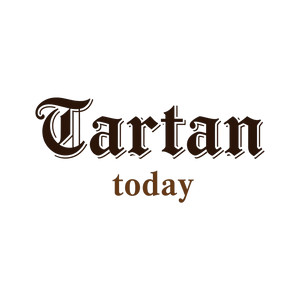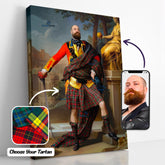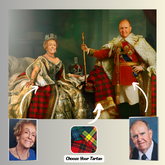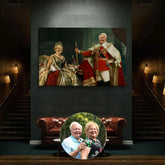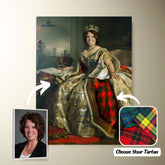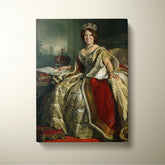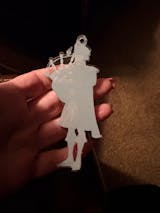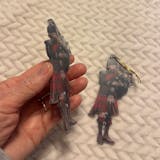-
Personalized Clan Buchan Ancient Tartan Bagpipe Ornament with Custom Name – Scottish Christmas Tree Decoration OF80
Personalized Clan Buchan Ancient Tartan Bagpipe Ornament with Custom Name – Scottish Christmas Tree Decoration OF80Celebrate your Scottish heritage with this unique wood & acrylic tartan ornament. Perfect as a personalized Christmas decoration or a meaningful gift for friends and relatives on special occasions...- From $19.99 USD
$25.99 USD- From $19.99 USD
- Unit price
- per
Save $6.00 -
Personalized Clan Buchan Modern Tartan Bagpipe Ornament with Custom Name – Scottish Christmas Tree Decoration ON94
Personalized Clan Buchan Modern Tartan Bagpipe Ornament with Custom Name – Scottish Christmas Tree Decoration ON94Celebrate your Scottish heritage with this unique wood & acrylic tartan ornament. Perfect as a personalized Christmas decoration or a meaningful gift for friends and relatives on special occasions...- From $19.99 USD
$25.99 USD- From $19.99 USD
- Unit price
- per
Save $6.00 -
Personalized Clan Buchan Ancient Tartan Drummer Ornament with Custom Name – Scottish Christmas Tree Decoration KE23
Personalized Clan Buchan Ancient Tartan Drummer Ornament with Custom Name – Scottish Christmas Tree Decoration KE23Celebrate your Scottish heritage with this unique wood & acrylic tartan ornament. Perfect as a personalized Christmas decoration or a meaningful gift for friends and relatives on special occasions...- From $19.99 USD
$25.99 USD- From $19.99 USD
- Unit price
- per
Save $6.00 -
Personalized Clan Buchan Modern Tartan Drummer Ornament with Custom Name – Scottish Christmas Tree Decoration DG66
Personalized Clan Buchan Modern Tartan Drummer Ornament with Custom Name – Scottish Christmas Tree Decoration DG66Celebrate your Scottish heritage with this unique wood & acrylic tartan ornament. Perfect as a personalized Christmas decoration or a meaningful gift for friends and relatives on special occasions...- From $19.99 USD
$25.99 USD- From $19.99 USD
- Unit price
- per
Save $6.00 -
Personalized Clan Buchan Weathered Tartan Bagpipe Ornament with Custom Name – Scottish Christmas Tree Decoration JV19
Personalized Clan Buchan Weathered Tartan Bagpipe Ornament with Custom Name – Scottish Christmas Tree Decoration JV19Celebrate your Scottish heritage with this unique wood & acrylic tartan ornament. Perfect as a personalized Christmas decoration or a meaningful gift for friends and relatives on special occasions...- From $19.99 USD
$25.99 USD- From $19.99 USD
- Unit price
- per
Save $6.00 -
Personalized Clan Buchan Reproduction Tartan Bagpipe Ornament with Custom Name – Scottish Christmas Tree Decoration PA67
Personalized Clan Buchan Reproduction Tartan Bagpipe Ornament with Custom Name – Scottish Christmas Tree Decoration PA67Celebrate your Scottish heritage with this unique wood & acrylic tartan ornament. Perfect as a personalized Christmas decoration or a meaningful gift for friends and relatives on special occasions...- From $19.99 USD
$25.99 USD- From $19.99 USD
- Unit price
- per
Save $6.00 -
Personalized Clan Banff and Buchan District Reproduction Tartan Bagpipe Ornament with Custom Name – Scottish Christmas Tree Decoration NT55
Personalized Clan Banff and Buchan District Reproduction Tartan Bagpipe Ornament with Custom Name – Scottish Christmas Tree Decoration NT55Celebrate your Scottish heritage with this unique wood & acrylic tartan ornament. Perfect as a personalized Christmas decoration or a meaningful gift for friends and relatives...- From $19.99 USD
$25.99 USD- From $19.99 USD
- Unit price
- per
Save $6.00 -
Personalized Clan Banff and Buchan District Modern Tartan Bagpipe Ornament with Custom Name – Scottish Christmas Tree Decoration ZW61
Personalized Clan Banff and Buchan District Modern Tartan Bagpipe Ornament with Custom Name – Scottish Christmas Tree Decoration ZW61Celebrate your Scottish heritage with this unique wood & acrylic tartan ornament. Perfect as a personalized Christmas decoration or a meaningful gift for friends and relatives...- From $19.99 USD
$25.99 USD- From $19.99 USD
- Unit price
- per
Save $6.00 -
Personalized Clan Banff and Buchan District Ancient Tartan Bagpipe Ornament with Custom Name – Scottish Christmas Tree Decoration PM85
Personalized Clan Banff and Buchan District Ancient Tartan Bagpipe Ornament with Custom Name – Scottish Christmas Tree Decoration PM85Celebrate your Scottish heritage with this unique wood & acrylic tartan ornament. Perfect as a personalized Christmas decoration or a meaningful gift for friends and relatives...- From $19.99 USD
$25.99 USD- From $19.99 USD
- Unit price
- per
Save $6.00 -
Personalized Clan Buchan Ancient Clan Crest Tartan Santa Ornament – Custom Acrylic Christmas Decoration WF28 - Buchan
Personalized Clan Buchan Ancient Clan Badge Tartan Ornament – Custom Acrylic Christmas Decoration WF28Celebrate your Scottish heritage with this unique wood & acrylic tartan ornament. Perfect as a personalized Christmas decoration or a meaningful gift for friends and relatives on special occasions such as...- From $19.99 USD
- From $19.99 USD
- Unit price
- per
-
Buchan
-
Personalized Clan Buchan Modern Clan Crest Tartan Santa Ornament – Custom Acrylic Christmas Decoration XA64 - Buchan
Personalized Clan Buchan Modern Clan Badge Tartan Ornament – Custom Acrylic Christmas Decoration XA64Celebrate your Scottish heritage with this unique wood & acrylic tartan ornament. Perfect as a personalized Christmas decoration or a meaningful gift for friends and relatives on special occasions such as...- From $19.99 USD
- From $19.99 USD
- Unit price
- per
-
Buchan
-
Personalized Clan Buchan Ancient Clan Crest Tartan Santa Ornament – Custom Acrylic Christmas Decoration UD73 - Buchan
Personalized Clan Buchan Ancient Clan Badge Tartan Ornament – Custom Acrylic Christmas Decoration UD73Celebrate your Scottish heritage with this unique wood & acrylic tartan ornament. Perfect as a personalized Christmas decoration or a meaningful gift for friends and relatives on special occasions such as...- From $19.99 USD
- From $19.99 USD
- Unit price
- per
-
Buchan
-
Clan Buchan Ancient Tartan Crest Rug – Scottish Highland Carpet for Living Room, Celtic Home Decor & Scotland Gift BU32
Clan Buchan Ancient Tartan Crest Rug – Scottish Highland Carpet for Living Room, Celtic Home Decor & Scotland Gift BU32Bring timeless Scottish charm into your home with our premium Tartan Area Rug. Designed with authentic Scottish tartan patterns, this rug is perfect for adding...- From $58.45 USD
- From $58.45 USD
- Unit price
- per
-
Clan Buchan Modern Tartan Crest Rug – Scottish Highland Carpet for Living Room, Celtic Home Decor & Scotland Gift JJ48
Clan Buchan Modern Tartan Crest Rug – Scottish Highland Carpet for Living Room, Celtic Home Decor & Scotland Gift JJ48Bring timeless Scottish charm into your home with our premium Tartan Area Rug. Designed with authentic Scottish tartan patterns, this rug is perfect for adding...- From $58.45 USD
- From $58.45 USD
- Unit price
- per
-
Clan Buchan Ancient Tartan Rug – Scottish Highland Carpet for Living Room, Celtic Home Decor & Scotland Gift KX57
Clan Buchan Ancient Tartan Rug – Scottish Highland Carpet for Living Room, Celtic Home Decor & Scotland Gift KX57Bring timeless Scottish charm into your home with our premium Tartan Area Rug. Designed with authentic Scottish tartan patterns, this rug is perfect for adding a...- From $58.45 USD
- From $58.45 USD
- Unit price
- per
-
Clan Buchan Modern Tartan Rug – Scottish Highland Carpet for Living Room, Celtic Home Decor & Scotland Gift VX32
Clan Buchan Modern Tartan Rug – Scottish Highland Carpet for Living Room, Celtic Home Decor & Scotland Gift VX32Bring timeless Scottish charm into your home with our premium Tartan Area Rug. Designed with authentic Scottish tartan patterns, this rug is perfect for adding a...- From $58.45 USD
- From $58.45 USD
- Unit price
- per
-
Custom Name Clan Buchan Modern Tartan Garden Flag with Clan Crest and the Golden Sword of Courageous Legacy RG69 - Buchan Modern
Custom Name Clan Buchan Modern Tartan Garden Flag with Clan Crest and the Golden Sword of Courageous Legacy RG69 Immerse your space in the rich heritage of Scotland with our Tartan Garden Flags, exclusively from Tartan Today. Featuring vibrant tartan and Scottish heritage designs, these...- From $34.45 USD
- From $34.45 USD
- Unit price
- per
-
Buchan Modern
-
Custom Name Clan Buchan Ancient Tartan Garden Flag with Clan Crest and the Golden Sword of Courageous Legacy CR77 - Buchan Ancient
Custom Name Clan Buchan Ancient Tartan Garden Flag with Clan Crest and the Golden Sword of Courageous Legacy CR77 Immerse your space in the rich heritage of Scotland with our Tartan Garden Flags, exclusively from Tartan Today. Featuring vibrant tartan and Scottish heritage designs, these...- From $34.45 USD
- From $34.45 USD
- Unit price
- per
-
Buchan Ancient
-
Clan Buchan Modern Tartan Scotland Map Canvas “Tartan Runs Through My Veins” Wall Art ZG37
Clan Buchan Modern Tartan Scotland Map Canvas “Tartan Runs Through My Veins” Wall Art ZG37Celebrate your Scottish heritage with this striking canvas print featuring the map of Scotland filled with Buchan Modern tartan, paired with the bold phrase: “Tartan Runs Through My Veins.” Whether...- From $35.05 USD
- From $35.05 USD
- Unit price
- per
-
Clan Buchan Ancient Tartan Scotland Map Canvas “Tartan Runs Through My Veins” Wall Art RR90
Clan Buchan Ancient Tartan Scotland Map Canvas “Tartan Runs Through My Veins” Wall Art RR90Celebrate your Scottish heritage with this striking canvas print featuring the map of Scotland filled with Buchan Ancient tartan, paired with the bold phrase: “Tartan Runs Through My Veins.” Whether...- From $35.05 USD
- From $35.05 USD
- Unit price
- per
Ex: Your Tartan + Product
Popular Products
Turn Me Royal Personalized Portrait from Your Photo, Custom Tartan. Custom Canvas Wall Art as Gift for Men
- From $32.45 USD
- From $32.45 USD
- Unit price
- / per
Royalty Couple Personalized Portrait from Your Photo, Custom Tartan. Custom Canvas Wall Art
- From $47.45 USD
- From $47.45 USD
- Unit price
- / per
The Queen Personalized Portrait from Your Photo, Custom Tartan. Custom Canvas Wall Art as Gift for Women
- From $32.45 USD
- From $32.45 USD
- Unit price
- / per
Which Clan Are You From?
- Apron
- Banff and Buchan District Ancient
- Banff and Buchan District Modern
- Banff and Buchan District Reproduction
- Buchan
- Buchan Ancient
- Buchan Ancient Gnome
- Buchan Ancient Tartan
- Buchan ClanBuchan Tartancar sun shade
- Buchan ClanBuchan TartanPillow Cover
- Buchan Modern
- Buchan Modern Gnome
- Buchan Modern Tartan
- Buchan Reproduction
- Buchan Tartan
- Buchan Tartan Clan
- Buchan Weathered
- Cumming
- Cumming Buchan Hunting
- Cumming Comyn Buchan
- Scott
List Of Tartan
-
Clan A
- Abercrombie Tartan
- Aberdeen Tartan
- Abernethy Tartan
- Adair Tartan
- Adam Tartan
- Ayrshire Tartan
- Agnew Tartan
- Aikenhead Tartan
- Ainslie Tartan
- Aiton Tartan
- Allan Tartan
- Alexander Tartan
- Allardice Tartan
- Allison Tartan
- Anderson Tartan
- Angus Tartan
- Anstruther Tartan
- Arbuthnot Tartan
- Armstrong Tartan
- Arnott Tartan
- Auchinleck Tartan
- Ayrshire Tartan
-
Clan B
- Baillie Tartan
- Bain Tartan
- Baird Tartan
- Balfour Tartan
- Bannatyne Tartan
- Bannerman Tartan
- Barclay Tartan
- Baxter Tartan
- Beaton Tartan
- Bell Tartan
- Belshes Tartan
- Bethune Tartan
- Beveridge Tartan
- Binning Tartan
- Bisset Tartan
- Blackadder Tartan
- Blackstock Tartan
- Black Watch Tartan
- Blair Tartan
- Blane Tartan
- Blyth Tartan
- Borthwick Tartan
- Boswell Tartan
- Bowie Tartan
- Boyd Tartan
- Boyle Tartan
- Brisbane Tartan
- Brodie Tartan
- Brown/ Broun Tartan
- Bruce Tartan
- Buccleuch Tartan
- Buchan Tartan
- Buchanan Tartan
- Burnett Tartan
- Burns Tartan
- Butter Tartan
- Byres Tartan
-
Clan C
- Cairns Tartan
- Calder Tartan
- Callander Tartan
- Cameron Tartan
- Campbell Tartan
- Campbell of Breadalbane Tartan
- Campbell of Cawdor Tartan
- Carmichael Tartan
- Carnegie Tartan
- Carruthers Tartan
- Cathcart Tartan
- Chalmers Tartan
- Charteris Tartan
- Chattan Tartan
- Cheyne Tartan
- Chisholm Tartan
- Christie Tartan
- Clark Tartan
- Clelland Tartan
- Clephan Tartan
- Clergy Tartan
- Cochrane Tartan
- Cockburn Tartan
- Colquhoun Tartan
- Colville Tartan
- Cooper Tartan
- Couper Tartan
- Craig Tartan
- Cranstoun Tartan
- Crawford Tartan
- Crichton Tartan
- Crief District Tartan
- Crosbie Tartan
- Cumming Tartan
- Cunningham Tartan
- Currie Tartan
- Clan D
- Clan E
- Clan F
- Clan G
- Clan H
- Clan I
- Clan J
- Clan K
- Clan L
-
Clan M
- Maitland Tartan
- Malcolm Tartan
- Mar Tartan
- Marjoribanks Tartan
- Maxtone Tartan
- Matheson Tartan
- Maule Tartan
- Maxwell Tartan
- Meldrum Tartan
- Melville Tartan
- Menzies Tartan
- Mercer Tartan
- Middleton Tartan
- Moffat Tartan
- Moncrieffe Tartan
- Montgomery Tartan
- Monypenny Tartan
- Moncreiffe Tartan
- Monteith Tartan
- Morrison Tartan
- Mouat Tartan
- Moubray Tartan
- Mow Tartan
- Muir_More Tartan
- Muirhead Tartan
- Munro Tartan
- Murray Tartan
- Murray of Atholl Tartan
-
Clan Mc/Mac
- MacAlister Tartan
- MacArthur Tartan
- MacAlpine Tartan
- MacAulay Tartan
- MacBain Tartan
- MacBean Tartan
- MacBeth Tartan
- MacCallum Tartan
- MacCraig Tartan
- MacColl Tartan
- MacCorquodale Tartan
- MacDiarmid Tartan
- MacDonald Tartan
- MacDonald of Clanranald Tartan
- MacDonald of Sleat Tartan
- MacDonnell of Glengarry Tartan
- MacDonnell of Keppoch Tartan
- MacDougall Tartan
- MacDowall Tartan
- MacDuff Tartan
- MacEwen_MacEwan Tartan
- MacEdward Tartan
- MacFarlane Tartan
- MacGill Tartan
- MacGillivray Tartan
- MacGregor Tartan
- MacGowan (McGowan) Tartan
- MacHardy Tartan
- MacIan Tartan
- MacInnes Tartan
- MacIntyre Tartan
- MacKay Tartan
- MacKillop Tartan
- MacKellar Tartan
- Mackinlay Tartan
- MacKenzie Tartan
- Mackie Tartan
- MacKinnon Tartan
- MacKintosh / MacIntosh Tartan
- MacLeod Tartan
- MacMillan Tartan
- MacNab Tartan
- MacNaughton Tartan
- MacNeil / MacNeill Tartan
- MacNeil of Colonsay Tartan
- MacNicol Tartan
- MacPhail Tartan
- MacPhee_MacFie Tartan
- MacPherson Tartan
- MacQuarrie Tartan
- MacQueen Tartan
- MacRae Tartan
- MacRow Tartan
- MacSporran Tartan
- MacTaggart Tartan
- MacTavish Tartan
- MacThomas Tartan
- McCorquodale Tartan
- McCulloch Tartan
- McFadzen Tartan
- McGeachie Tartan
- McIver Tartan
- McKerrell Tartan
- Clan N
- Clan O
- Clan P
- Clan R
-
Clan S
- Sandilands Tartan
- Scott Tartan
- Scrymgeour Tartan
- Selkirk Tartan
- Sempill Tartan
- Seton Tartan
- Shaw Tartan
- Shepherd Tartan
- Sinclair Tartan
- Skene Tartan
- Skirving Tartan
- Smith Tartan
- Somerville Tartan
- Spalding Tartan
- Spens Tartan
- Spottiswood Tartan
- Stevenson Tartan
- Stewart Tartan
- Stewart of Appin Tartan
- Stirling Tartan
- Strachan Tartan
- Straiton Tartan
- Strange Tartan
- Strathclyde District Tartan
- Stuart of Bute Tartan
- Sutherland Tartan
- Swinton Tartan
- Clan T
- Clan U W Y
- Request Your Clan
Clan Buchan (Buchan Tartan)
1. About Clan Buchan (Buchan Tartan)
2. Clan Buchan History (Buchan Tartan)
It is crucial to note, however, that local nobles would have also used the name, even if they might not have had a clear connection to their Earls.
The family began to exert influence over Auchmacoy from the beginning of the 14th century, but it wasn't until James IV granted Andrew, the second chief, a charter to the lands in 1503 that they came under their control.
Throughout a protracted battle with General Mackay's government forces, Buchan guided the Jacobite forces.
3. Clan Buchan Tartans
While "modern" refers to darker dye colours, "ancient" refers to the dye shades, which are typically lighter.
Threadcount K/4 R4 G54 R4 K12 B4 G12 R4 K48 R4 K4 B4 R4 K48 R4 G12 R12 B4 K12 R4 G54 R4 K/4
4. Clan Buchan Crest & Coats of Arms
4.1 Clan Buchan Crest
Worn by all of the name and ancestry
4.2 Clan Buchan Coat of Arms
5. Clan Buchan Places & People
5.1 Clan Buchan Places
Auchmacoy House
The Clan Buchan has owned the Auchmacoy estate in Aberdeenshire for more than 700 years. In 1830, the former Auchmacoy House was replaced by the present structure.
5.2 Clan Buchan People
Alexander Buchan (11 April 1829 - 13 May 1907)
The name "Buchan Spells," which derives from Alexander Buchan, who first observed these aberrations from the typical predicted seasonal temperatures, is often used in meteorology. He made the weather map the cornerstone of weather prediction.
5.3 John Buchan (26 August 1875 - 11 February 1940)
Son of a minister who attended Glasgow and Oxford colleges before being admitted to the bar in 1901. He is renowned for penning "The Thirty-nine Steps," which Alfred Hitchcock popularized in his movie of the same name.
From 1935 until his passing at the age of 64 in 1940, Buchan served as Canada's 15th governor general.
6. Associated Names
Although there are no recognized septs within Clan Buchan, the following surnames have been associated with the Buchan region in Scotland's northeast:
Basken, Baskin, Bede, Bichan, Bichen, Bonnieville, Boyne, Buck, Buckie, Bucky, Cawsell, Chapp, Chrystal, Clapperton, Coscrach, Costie, Costy, Cranach, Crannach, Cruddon, Cruden, Crudon, Crystal, Crystal, Crystall, Fitchie, Fitchy, Gammerie, Gammery, Hardin, Hardman/ Hardnan, Kermack, Leisk, Mac, Meason, Merson, Mondie, Mondy, Mundie, Mundy, Nible, Niblo, Ogston, Ogstone, Ogstoun, Prince, Ratcliff, Ratliff, Rattcliff, Rattliff, Runcie, Runcy, Shakle, Tarves, Tarvis, Teunion, Teunon, Tewnion, Tinnon, Tucks, Wadsworth, Wadsworther, West, Whammond, Whyman, Whymon, and Willgook
- Choosing a selection results in a full page refresh.
